Basque style chicken, known as poulet basquaise in French, is the South-West traditional braised chicken with tomato, bell pepper, and the local chili piment d’Espelette.
I brought back the authentic recipe for Basque chicken from where this peppery braised chicken originates from my trip last Summer in South West France’s Basque region near the Spain border.
We actually call this area le pays Basque, lit—the Basque country. I went to the city of Espelette, where the famous chili used in this recipe comes from. Don’t worry, you’ll find substitutes.
I met an adorable grandmother at the farmers market who confirmed that my way of making this traditional recipe corresponded to the proper recipe.
This region of France is really worth visiting. It has typical houses with red, green or blue wooden structures that are absolutely beautifully, making the small villages in the country side absolutely stunning. I couldn’t resist adding to this recipe a few photos of the houses and the peppers.
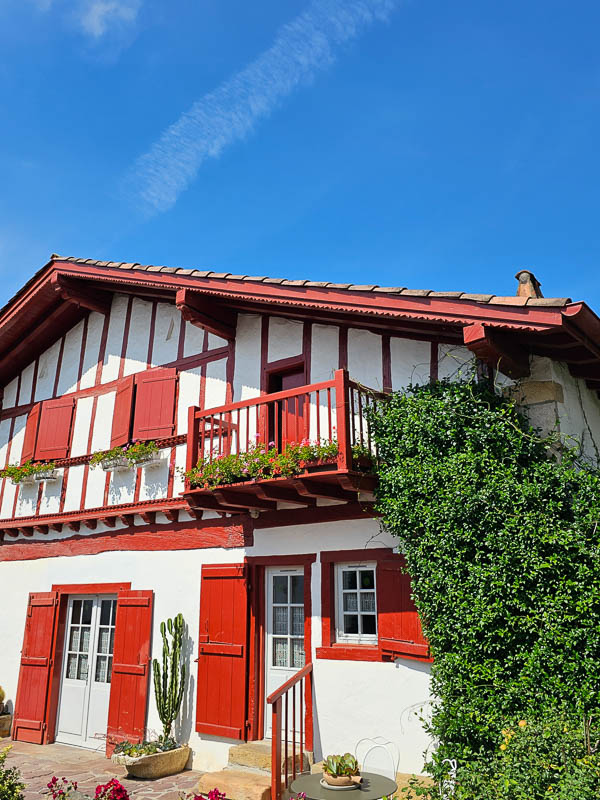
Origin of chicken basquaise
Chicken Basquaise is actually made with a base of piperade: a compote of tomatoes, local sweet peppers (often substitutes with bell pepper), and onions, gently simmered and to which is added the local star spice: piment d’Espelette AOP chili pepper.
In a piperade, you can add eggs or cured ham (Bayonne ham is the local cured ham used) to make a complete dish. Or chicken, as in this recipe for poulet basquaise.
If I understood correctly, chicken à la Bayonnaise is Basque-style chicken into which bacon or cured ham is added.
Those recipes are quite easy to make, plus you can decline several others from one recipe, the piperade.
The ingredients you need for a perfect basque chicken
Chicken, of course
Either whole, thighs, or eventually, breasts
Use a whole chicken and ask your butcher to cut it into pieces.
Alternatively, use chicken thighs, ideally a mix of drumsticks and thighs, attached or separate. Be careful if you use chicken breast, as they cook a bit faster.
Piment d’Espelette, or substitute to chili or Cayenne pepper
Espelette pepper (piment means pepper in French) is the local chili pepper cultivated in South-west France.
Piment d’Espelette pepper benefits an AOP Appélation d’Origine Protégée (protected designation of origin) certification that describes very strict specifications regarding location, variety, growing and harvesting… For instance, “the peppers must be harvested by hand when ripe, they must measure between 7 and 14 cm and have a regular, conical shape and a smooth skin when red. They should dry naturally for at least 15 days… “
The name comes from the Espelette town located a few kilometers away from the Atlantic Ocean and just next to Spain border. Piment d’Espelette is grown in ten locations: Ainhoa, Cambo-les-bains, Espelette, Halsou, Itxassou, Larressore, Saint-Pée-sur-Nivelle, Souraïde and Ustaritz.
The hills to the east and the Ocean to the west create a unique microclimate with abundant spring rainfall and high summer temperatures. The late season offers a mild climate, ideal for growing chilies and ripening fruit from September to October.
Piment d’Espelette is a hot spice with a moderately intense spiciness (4/10 on the Scoville scale measuring the intensity of pepper spiciness). It has a long-lasting flavor with great finesse and persistent taste.
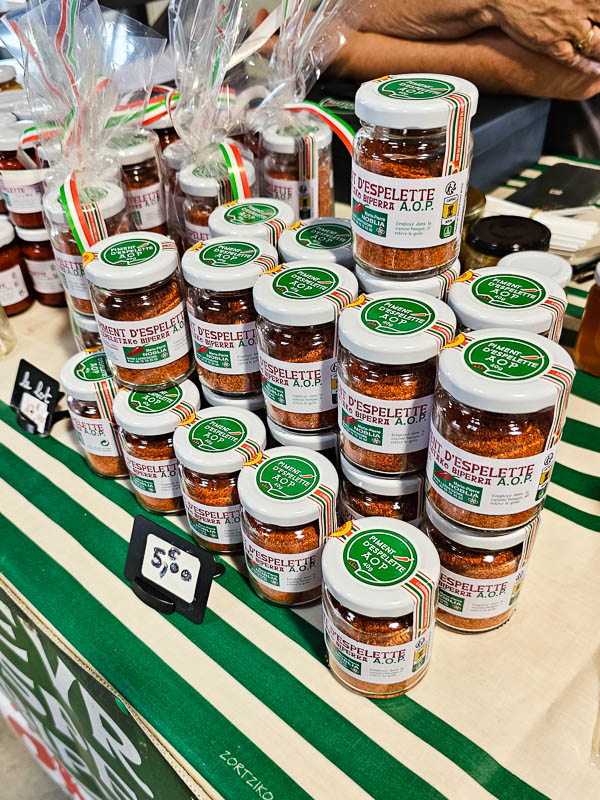
Which substitute to Piment d’Espelette ?
I totally understand most of you won’t have this specific French spice. You can replace it by any chili pepper you like. Cayenne pepper, for example.
Adjust the quantity to the spiciness you want and that your organism can tolerate!
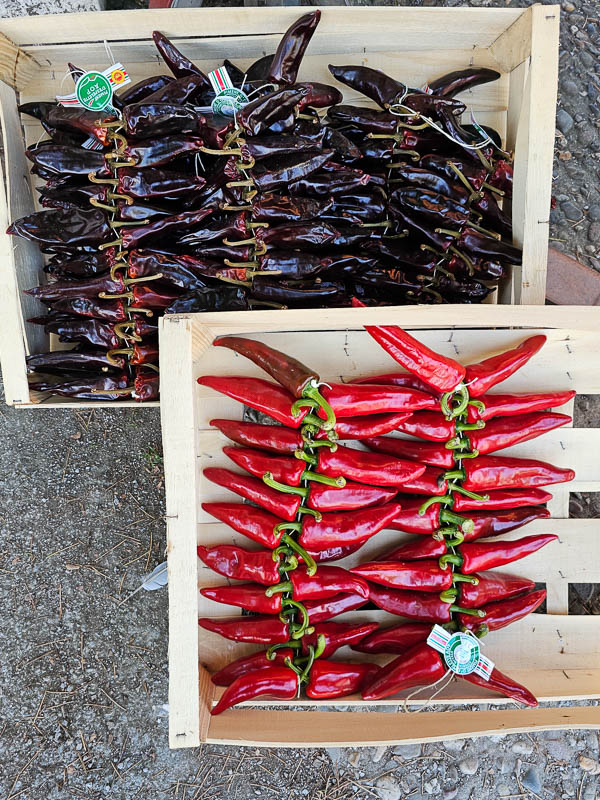
Bell pepper of local Anglet sweet pepper
The authentic recipe uses a local sweet pepper, called piment doux d’Anglet, with a thin and long shape as in the photos, but those are difficult to find even in other parts of France. Therefore, I’ve adapted the recipe with red and green bell peppers, which is what most French cooking this recipe in other parts of France do anyway.
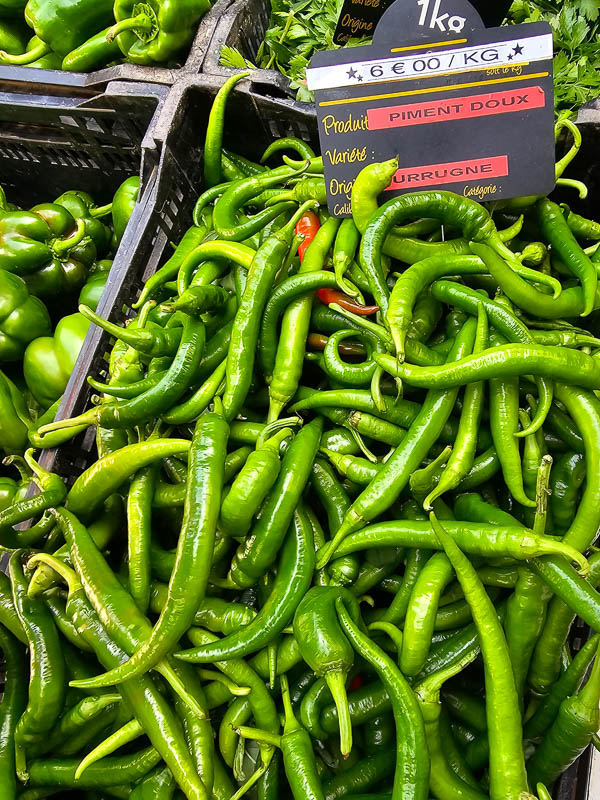
Tomatoes
Fresh or tinned. Outside tomato season, it’s better to use tinned tomatoes. In France, we can find them tinned either whole and peeled or cut into cubes. Avoid choosing tomato sauce; we want consistency for this recipe.
You know that the French love to go to the farmers market to buy local products. If you want to have good-quality ingredients, it’s crucial to respect seasonality. When not in season, I believe that it’s better to have good quality tinned tomatoes than tomatoes with no taste frown under artificial lights in heated farms or that few from the other side of the world.
In this recipe, if you use fresh tomatoes I suggest peeling the tomatoes. This step of course, is optional. However, having tomatoes without skins will bring much more smoothness to the sauce of your basquaise chicken.
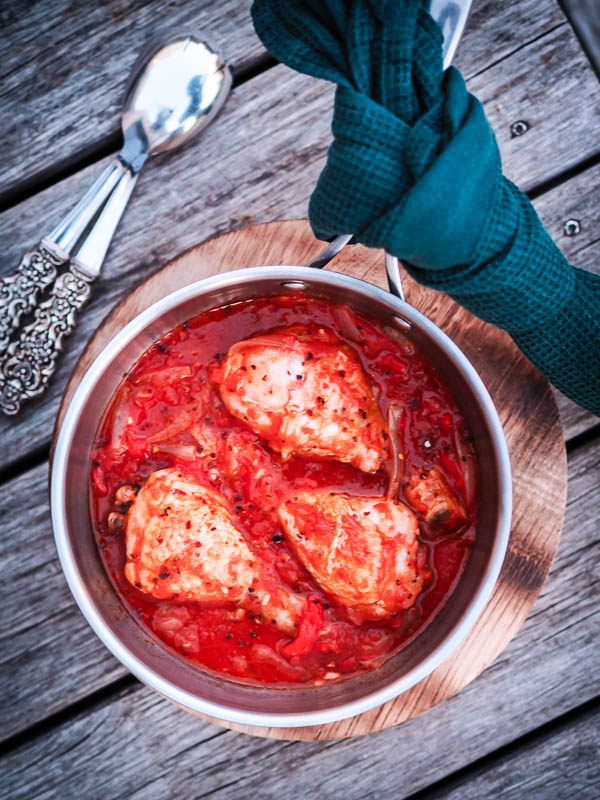
How to peel tomatoes
You’ll need: a large pot of boiling water, a bowl of cold water to cool down the tomatoes, a knife, and, ideally, a skimmer.
- Start by bringing a large pot of water to the boil.
- Meanwhile, wash the tomatoes, remove the stalks, and, using a knife, make a cross-shaped incision in each tomato.
- Place the tomatoes one by one in the water as soon as the water boils. To avoid splashing and the risk of burning, you can, for example, place tomatoes in a ladle and immerse it in the boiling water. Repeat if necessary.
- Leave the tomatoes in the boiling water for 30 seconds, then remove them with a skimmer.
- Refresh the tomatoes in the cold water bath.
- Finally, remove the skin. Depending on the variety and degree of ripeness of the tomatoes, the skin should come off easily by hand, or you can use a knife.
What side to serve with this poulet basquaise
I would say just rice as you have a generous tomato sauce with lots of red and green pepper. This is a kind of one-pot chicken dish. No need for other sides as for any stew.
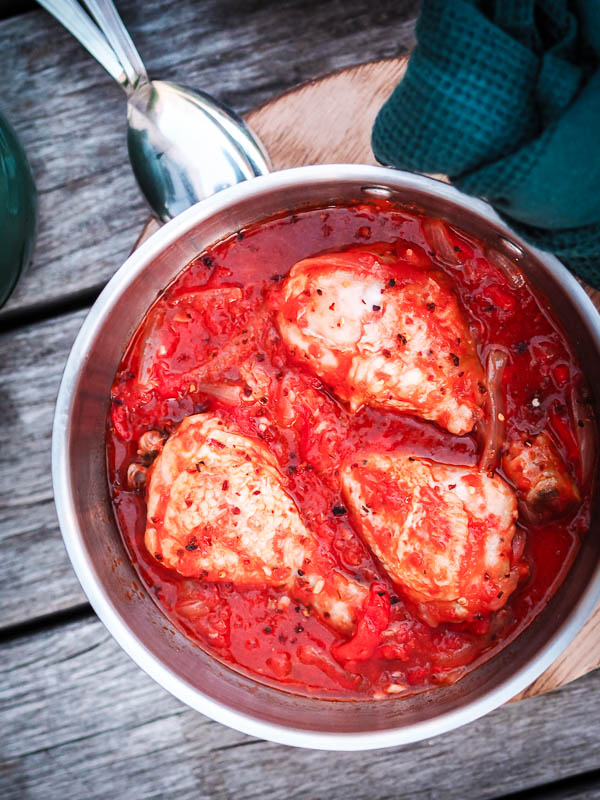
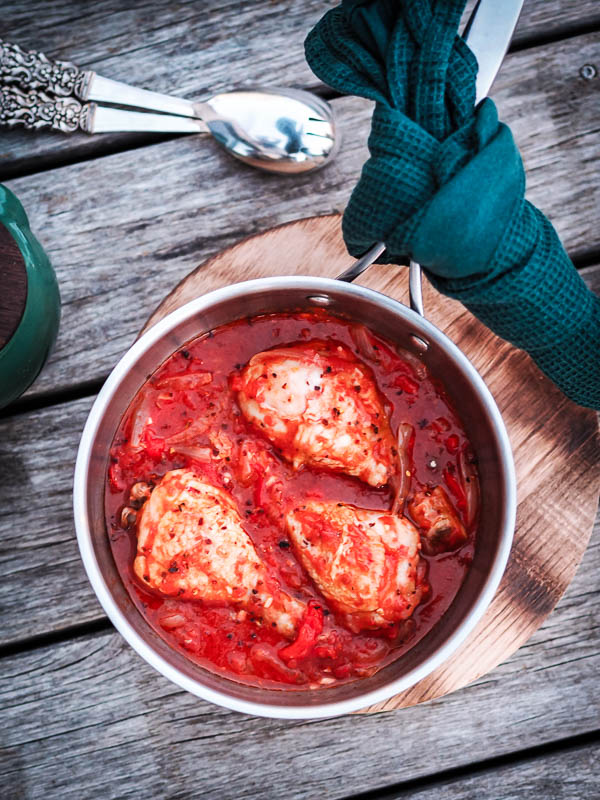
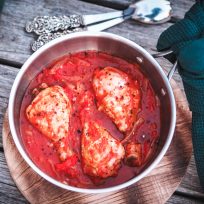
Basquaise chicken
Ingredients
- 1 chicken or 4 thighs, ideally a mix of drumsticks and thighs
- 1 kilo tomato or tinned tomatoes diced or peeled
- 2 cloves garlic
- 2 onions large
- 2 red bell peppers
- 1 green bell pepper or 8 local Anglet sweet peppers
- 4 tablespoons oil for the pan
- salt
- pepper freshly grounded
- 1 pinch Espelette pepper Substirures chili or cayenne pepper
Instructions
Brown the chicken
- Use chicken thighs or a whole chicken cut into pieces.
- Heat 2 tablespoons of oil in a sauté pan over medium heat. Season chicken on all sides with salt and pepper and fry the chicken pieces until nicely golden browned about ten minutes.
Prepare the vegetables
- Meanwhile, prepare the tomatoes. Use canned tomatoes, or if fresh tomatoes, ideally peel them (but this is optional):– Remove the stalk and make a knife cross incision in the skin.– Bring a large pot of water to the boil, plunge the tomatoes in for 30 seconds.– Remove tomatoes, cool them in a water bath, and peel them.
- Cut the tomatoes into quarters and remove the seeds.
- Peel and chop the onions. Keep the garlic cloves whole with the skin and crush them with the flat part of a knife blade. We use the garlic clove whole, leaving the skin on, but if you prefer, peel and mince the garlic.
- Wash the bell peppers and remove the stalks and inner seeds. Cut into strips.
Cook the chicken basquaise
- Remove the browned chicken pieces from the pan and set aside on a plate.
- Add two tablespoons of oil to the pan, and sauté onion, garlic, and bell peppers. Cook over medium heat for 10 to 15 minutes.
- Add the tomatoes and cook over medium heat for 20 minutes. Stir occasionally.
- Finally, add the chicken thighs, season with salt and pepper, and cook over medium-low heat for 30 more minutes.
- 10 minutes before the end of the cooking time, taste, adjust the salt and pepper seasoning, and sprinkle with a pinch of Espelette pepper.
Notes
See in the articles information on South west France local pepper Piment d’Espelette and sweet peppers that can be replaced by chili or cayenne pepper and bell peppers.
